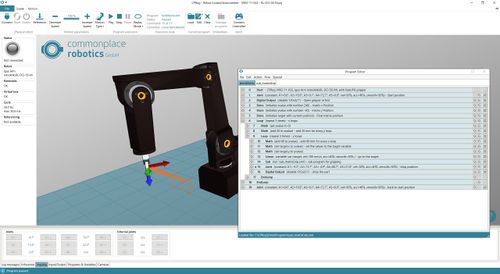CPRog Examples
This page shows an example program for the CPRog software v980-10-XXX
Demo - First Program
In this video we demonstrate the programming and control of a robolink DCi robot. The DCi is a compact robot with integrated electronics and a linux single board computer, so that once the program is written in CPRog on an external PC, the DCi can operate and run a program without any connection to an external PC: Robolink DCi Programming in CPRog. Programming of other robolink robots is identical but requires the external PC to remain connected during execution of the program.
Structured programming using Sub-Programs and Matrix Motion
The article Structured_Programming gives a short introduction on how to use sub-programs and the matrix command. A pick-and-place example can be downloaded there as well.
Matrix Motion
This example shows the manual approach of handling matrices using loop commands, please refer to the previous section for the integrated matrix command!
In order to grip work pieces form a rectangular tray one has to control the robot so that it moves a new position and then operates the gripper. The motions have to be carried out multiple times for multiple items on the matrix. To simplify setting up such a motion, CPRog can handle loops and subprograms. In this case once would program two loops: one that increment the x and y of the target position and a second loop that controls the gripping motion. Here some example code that accomplishes this task:
Program Files
- Download the following xml files (right click, save as) and save both of them in the directory
C:\CPRog\Data\Programs.- The main program testMatrix.xml
- The gripping sub program sub_matrixGrip.xml
- Load the
test.matrix.xmlprogram in CPRog by clicking on the folder symbol in the menu ribbon at the top right.
![]() Always first test any program in a simulation, i.e. with the robot disconnected in software. The starting positions of the example code may have to be adapted to your specific set up!
Always first test any program in a simulation, i.e. with the robot disconnected in software. The starting positions of the example code may have to be adapted to your specific set up!
Please refer to the CPRog/iRC documentation for further information on the commands and variables.
Troubleshooting
- If the robot does not perform the complete pattern, please check if the motion might exceed the motion limits. This is shown in the log messages tab on the bottom of CPRog.
- Take a look at the variables in the "variables" tab on the bottom of CPRog. This often helps to find problems.
- Precision: If the real robot approaches the positions with offsets it might be necessary to perform a fine calibration. Please have a look at the according page Define the zero position offsets or get in contact!
Glue Application
Article not finished right now. We are still working on it.
This example shows how to use Logik Programs to set a DO during a motion. This is helpful e.q. for a gluing application.
In the following picture you can see finished mainprogram. The xml Programm Files can be ddownloaded here: https://wiki.cpr-robots.com/images/f/f3/GlueingExamples.zip . The Goal of this example is that the robot makes 3 parallel Lines of Glue. First, we program the motion of the Robot.
- (Instruction 1): Drive to start position.
- (Instruction 2): Drive to X and Z Value of start position for the gluing. The y value should be smaller than the value you want to start with your glue.
- (Instruction 4): Move Robot in y value, choose a higher value than your glue should be
- (Instruction 6 + 7): Move to Start point for the next line of Glue, y value must be smaller than the value you want to start your glue.
- (Instruction 9): Move Robot for second glue line.
- (Instruction 11+12): Move to Start point for the third line of glue like in step 4
- (Instruction 14): Move Robot for third line of glue.
- (Instruction 13): Move robot to start Position.
After defining the motion of the robot, we need to define the Logik of DOut of Glue. In the following picture you can see the Logik Program of this application. You can download the xml file here.
The DOUT for Glue in this example is DOut27. The Glue should be added, if the y-Position of the robot is between 50 and 125. If the robot is out of this range, DOut27 should be disabled.
- (Instruction 1 to 11): Create a Loop whit false as condition, so this program will never end. You need this loop, because Programs have a minimum execution time of 500ms. Shorter programs, for example fast running logic programs, may be delayed during the automatic restart.
- (Instruction 3 to 8): You need a if-else condition to check whether the y-Position of the robot is in range for gluing.
- (Instruction 5 +7): Set and Reset DOut 27
If you will start the program now, the DOut 27 will be activated every time the y-value is in the defined range. This also means for example if you move the robot manually. To stop that you need a global signal which defines weather the robot is allowed to start glue. This global signal (GSig1 in our case) is set before every motion of glue. This is done in Instruction 3,8 and 13. After motion with glue activated the glue DOut must be deactivated. This is done in Instruction 5,10 and 15. This GSig1 has now be added in the Logik Program. Only if GSig1 is activated the DOut 27 can be set (Instruction 3).
In the following video is the complete program.
Support
For questions please get in contact
